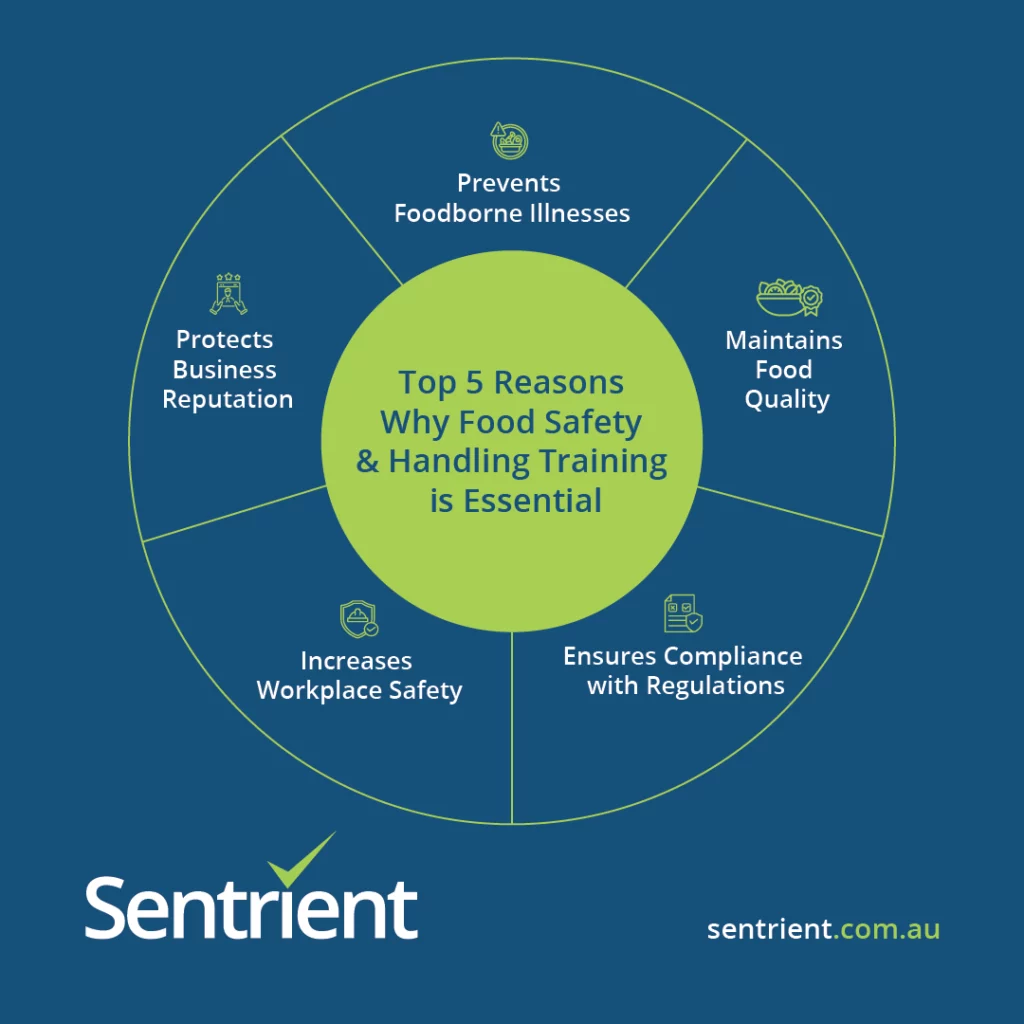Adhering to food safety practices is essential for the well-being of individuals and the overall health of society. Proper handling, storage, and preparation of food helps prevent contamination, keeping your employees and consumers safe.
Businesses that prioritise food safety and employee food safety training not only comply with regulations but also build trust with their customers and clients. Without proper training, employees may unknowingly contribute to foodborne illnesses, leading to serious health risks.
A strong food safety culture ensures a safer work environment and reduces risks across food production and service operations. Understanding hygiene protocols, correct food handling methods, and industry safety standards is essential in preventing contamination.
In this blog, we will explore the importance of food safety and handling training and how it plays a crucial role in maintaining compliance, improving efficiency, and protecting business reputation. Let’s get started!
What is Food Safety and Handling Training?
Food Safety and Handling Training is a structured program designed to equip individuals with the essential knowledge and skills for safe food handling. It covers key aspects such as personal hygiene, contamination prevention, proper food storage, and effective cleaning procedures. These practices help maintain food quality and reduce risks to public health.
This training ensures that food is handled in compliance with regulatory standards, preventing foodborne illnesses and contamination. It teaches employees the importance of following hygiene protocols and safe handling techniques.
Businesses benefit from improved operational efficiency and adherence to legal requirements, safeguarding their reputation and customer trust. Employees gain confidence in handling food correctly, minimising waste and enhancing overall safety.
Top 5 Reasons Why Food Safety and Handling Training is Essential

1. Prevents Foodborne Illnesses
Proper training ensures food is handled safely, reducing bacterial contamination and lowering the risk of food poisoning. Employees learn safe preparation, cooking, and storage techniques to prevent common foodborne illnesses. Regular training updates help staff stay informed about evolving food safety standards and best practices.
2. Ensures Compliance with Regulations
Businesses must follow strict food safety laws to meet legal requirements and avoid penalties. Training helps employees understand these regulations and implement necessary food safety practices in daily operations. Compliance reduces the likelihood of legal issues and ensures businesses maintain their operating licences.
3. Maintains Food Quality
Correct storage, handling, and preparation techniques preserve food’s nutritional value and freshness. Well trained staff minimise spoilage and ensure food remains safe for consumption. Consistently following best practices improves customer satisfaction by delivering high quality food products.
4. Protects Business Reputation
Food safety violations can lead to negative publicity, financial losses, and customer distrust. Investing in training helps maintain high safety standards and protects a business’s credibility in the industry. A strong reputation for food safety can increase customer loyalty and attract new business opportunities.
5. Increases Workplace Safety
Training covers personal hygiene, potential cross contamination, safe food storage, proper cooking techniques and more. Employees learn to follow safety protocols, creating a secure and hygienic work environment. Reducing potential foodborne illnesses improves employee well-being and maintains operational efficiency.
7 Factors to Consider When Choosing a Food Safety and Handling Training Program
Selecting the right training program is crucial to ensuring food safety compliance and effectiveness. Here are key factors to keep in mind:
1. Accreditation and Compliance
The program should comply with Australian food safety standards and be recognised by relevant authorities. This ensures that the training aligns with legal requirements and industry best practices.
2. Course Content
A well structured program should cover hygiene, contamination prevention, food storage, and regulatory compliance. Comprehensive content ensures participants gain a thorough understanding of safe food handling practices.
3. Training Format
Options include online, in-person, or blended learning, depending on convenience and industry requirements. Choosing the right format helps participants engage effectively and retain crucial knowledge.
4. Industry Relevance
Different food sectors have unique safety requirements, whether in hospitality, retail, or manufacturing. A program tailored to specific industries ensures that employees receive training applicable to their work environment.
5. Certification and Validity
The training should provide a recognised certificate with a clear validity period. Certification demonstrates compliance and ensures employees stay updated with industry standards.
6. Trainer Expertise
Instructors should be experienced professionals with extensive knowledge of food safety regulations. Expertise in the field enhances the learning experience and provides valuable industry insights.
7. Cost and Accessibility
Course fees, duration, and accessibility should align with individual or business needs. Comparing options helps find a program that balances affordability with quality training.
Sentrient’s Food Safety and Handling Training Course
Sentrient provides an online Food Safety and Handling Training Course designed to educate employees, contractors, and volunteers on best practices for food safety. The course, which takes approximately 15 minutes to complete, covers crucial food handling aspects to help organisations prevent contamination and ensure compliance.
Key Topics Covered:
- Importance of Food Safety – Understanding the impact of safe food practices on public health and business operations.
- Personal Hygiene Requirements – Following cleanliness standards to prevent foodborne illnesses.
- Preventing Food Contamination – Identifying and mitigating risks in food handling processes.
- Safe Food Storage Practices – Implementing best practices for food preservation.
- Cleaning vs. Sanitisation – Understanding the difference between cleaning methods for maintaining a hygienic environment.
- Food Handling in Various Settings – Adapting safety practices to different food service industries.
Completing this training enables participants to implement effective food safety measures, reducing risks and ensuring adherence to food safety laws.
Conclusion
Food Safety and Handling Training is a fundamental practice that safeguards public health, enhances business reputation, and ensures compliance with regulations. Proper training provides employees with the skills to maintain hygiene, handle food correctly, and prevent contamination, which contributes to a safer food environment for businesses and consumers.
Implementing effective food safety measures reduces risks and ensures operational efficiency. A well-trained workforce can maintain compliance with food safety laws, protect brand reputation, and build customer trust. Businesses that prioritise food safety training create a positive impact on the industry and set high operational standards.
To learn more or enrol in Sentrient’s Food Safety and Handling Training Course, contact us today. Equip your team with the necessary knowledge to handle food safely and uphold the highest food safety standards in your organization.
FAQ’s:
1. What is food safety and handling training?
This training educates individuals on proper methods to prepare, store, and serve food to prevent contamination and foodborne illnesses.
2. Why is food safety training important?
It ensures that food handlers understand how to minimise risks of foodborne diseases, maintain hygiene standards, and comply with legal requirements.
3. Who needs to undergo food safety training?
Anyone involved in the preparation, storage, or service of food, including restaurant staff, caterers, and food manufacturers.
4. What topics are covered in food safety training?
Subjects typically include personal hygiene, cross-contamination prevention, temperature control, cleaning and sanitising procedures, and allergen management.
5. Is food safety training legally required?
In many regions, such as Australia, it is a legal requirement for food handlers to be trained in food safety.
6. How often should food safety training be updated?
Regular updates are recommended to keep up with changing regulations and best practices; some jurisdictions may specify renewal periods.
7. What are the consequences of not having food safety training?
Non-compliance can lead to legal penalties, foodborne illness outbreaks, damage to business reputation, and financial losses.
8. Can food safety training reduce food waste?
Yes, proper training helps in understanding correct storage and handling, thereby minimising spoilage and waste.
9. How does food safety training protect customers with allergies?
It educates staff on identifying allergens, preventing cross-contact, and responding appropriately to allergic reactions.
10. What is the role of a Food Safety Supervisor?
A designated individual responsible for ensuring that food safety practices are followed, and that the establishment complies with food safety regulations.






